Wondering what animals in Florida there are – including the most wild, dangerous and invasive animals in the Sunshine State.
The gorgeous state of Florida is home to a wide variety of interesting fauna. As a Florida native myself, I’ve had many encounters with the abundant wildlife in the state.
From petting Key Deer, to (hurriedly) swimming away from jellyfish, the following article will let you know which native animals you may come across during your adventures in the sunshine state!
14 Cool Native Animals in Florida You Might See!
1. Florida Panther (Puma concolor coryi)
Let’s kick things off with the state animal of Florida, the panther!
As the mascot for Florida’s National Hockey League team, and mascot for many Florida schools, my high school included, this mighty wildcat holds quite a reputation for being fierce and strong.
That reputation is well-earned! It’s a fairly common animal to spot, especially in Central Florida near Orlando, but I wouldn’t recommend getting too close! The best places to see Florida Panthers include many of the state parks, such as Ellie Schiller Homosassa Springs Wildlife State Park, Collier-Seminole State Park, or Fakahatchee Strand Preserve.
Like most other wildcats, the panther is a carnivore, meaning it only eats meat. Their diets primarily include wild hogs and white-tailed deer, but they also hunt many small mammals such as armadillo, rabbits and raccoons.
One of the most unique native Animals in Florida. Pity they are not easier to spot!
Fun Facts!
- The Florida panther is, sadly, an endangered species.
- Even though these panthers are commonly spotted in Central Florida, all breeding takes place in South Florida.
- While panthers may call the sunshine state their home, they actually prefer to live in the forested areas, tropical hardwood hammocks, and mixed freshwater swamp forests. In other words, you’ll probably never find one sunning itself on the beach!
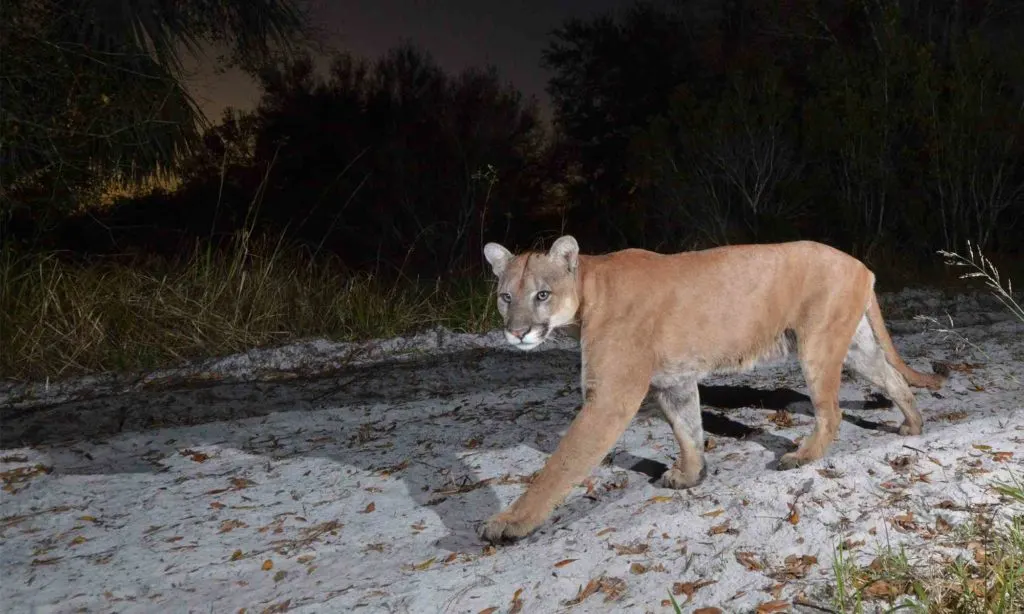
Manatee (Trichechus manatus latirostris)
Meet the manatee! They are also known, adorably, as the sea-cow.
These large and slow-moving mammals are roughly 9 to 10 feet long, and can weigh close to 1000 pounds! You’ll find manatees all around Florida’s coastal waters, springs, and rivers. During the warmer parts of the year, some migrate up the eastern coastline into Georgia and the Carolinas.
Manatee sightings are pretty common around South Florida intracoastal waterways, although you might not be sure what you’re seeing at first. Manatees can look still and unmoving as they slowly glide through the currents, but if you look closely, you’ll see it’s snout poke through the surface! These lovely creatures are aquatic herbivores, meaning their diet almost entirely consists of seagrass and aquatic vegetation.
If you’re hoping to spot some wild sea-cows for yourself, try heading over to Blue Spring State Park in Orange City, or take a stroll along the inlet in Lighthouse Park, located in the town of Jupiter.
You can go kayaking with manatees in multiple places around Florida and you can also swim with manatees in Three Sisters Spring along Crystal River.
Fun Facts!
- Manatees eat up to 10% of their body weight in food per day!
- When on-the-go, manatees must surface every 3 to 5 minutes to breathe. However when resting, they can hold their breath for up to 20 minutes!
- While they are fairly social animals, manatees do not typically travel together in pairs or groups. Unless, of course, a mother manatee is with her newly born calf.
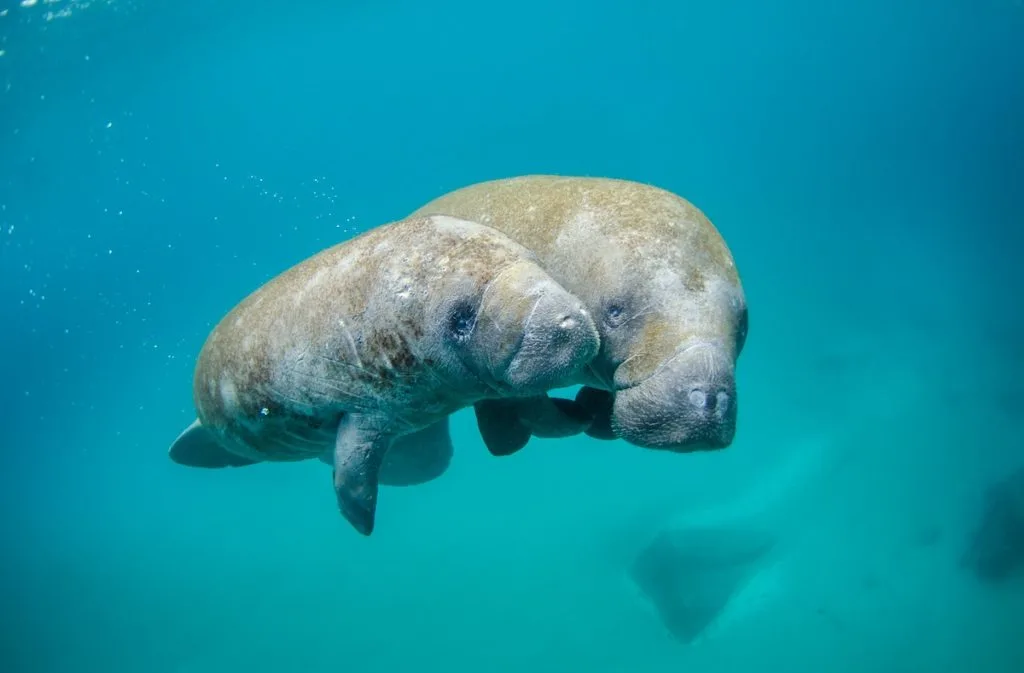
Native American Alligator (Alligator mississippiensis)
When you hear “Florida,” it’s likely that 3 things will simultaneously come to mind: beaches, swamps, and alligators. But despite popular opinion, the Native American Alligator has much more going for it besides wrestling and “Florida Man” news headlines.
Let’s get into it!
Alligators prefer freshwater habitats, such as lakes and rivers, over saltwater ones, although they can sometimes be spotted in areas with brackish water. If you’re looking for alligators, I highly recommend visiting the Everglades National Park! You can also find wild alligators in Audubon Corkscrew Swamp Sanctuary in Naples, Florida…or maybe even in someone’s swimming pool. A rare occurrence, but hey, it happens.
Native American Alligators are opportunistic feeders, which means that they will eat almost anything that is unfortunate enough to get in their way. However, an alligator will almost never go after prey that is larger than itself. A young or small alligator’s diet typically includes insects, small fish, or amphibians, while an adult alligator will go after small mammals, birds, turtles, and snakes.
Fun Facts!
- Alligators are much larger than you think. The largest alligator recorded in Florida was over 14 feet long!
- The biggest threat to alligator habitats is human development. As humans develop properties and create pollution, the wetlands of Florida continue to shrink year-by-year.
- More than any other modern reptile, alligators are the closest in relation to dinosaurs! *Cue Jurassic Park theme song*
Some of the best places to see alligators in the Everglades are Shark Valley and the Anhinga Trail. You can see a full list of the best hiking trails in the Everglades if you want to try your luck on a walk.
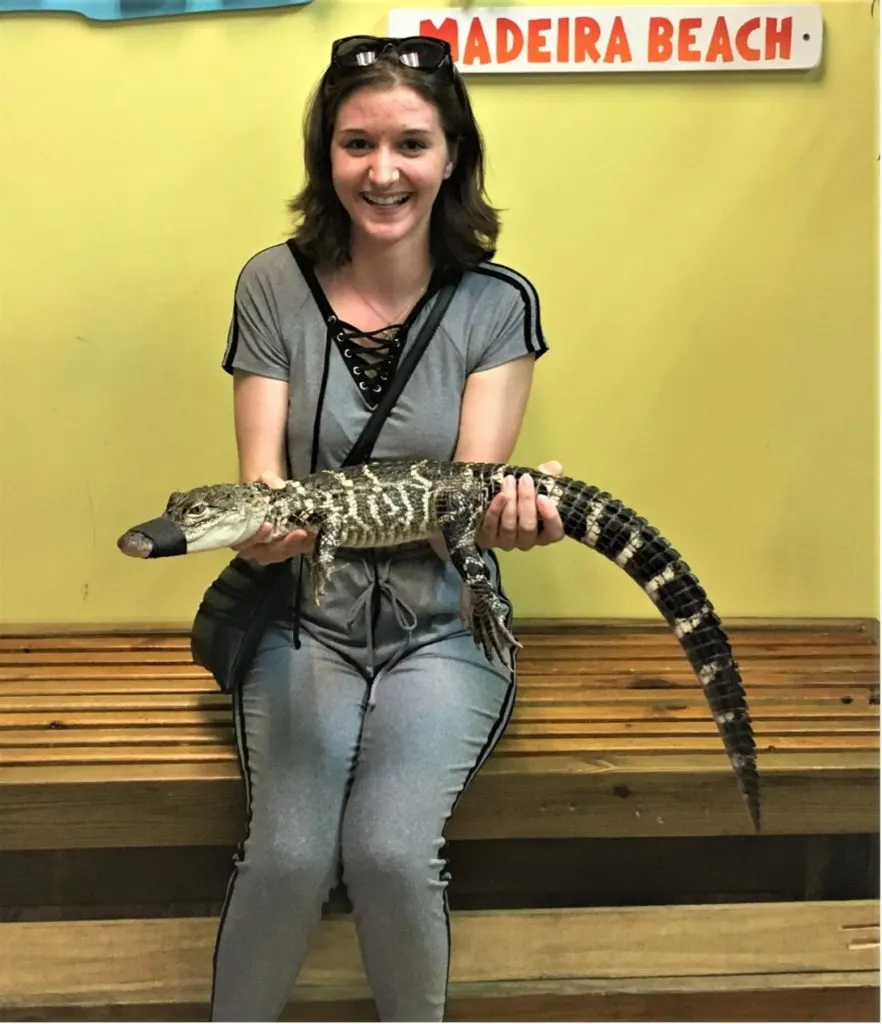
Key Deer (Odocoileus virginianus clavium)
Key Deer are definitely one of my favorite animals. They are the cutest things I’ve ever seen, and they’re tiny. Even full-grown bucks stand shorter than 4 feet tall, and weigh less than 80 pounds on average. I’m telling you, the cuteness level is up there right next to babies and puppies.
This species of deer is unique because they can only be found in the Florida Keys. If you’re out around dawn or dusk, odds are, you’ll see these little deer everywhere…and I mean everywhere. In Big Pine Key, and the adjoining No Name Key, Key Deer are easily spotted along the streets, around shops and businesses, and even in front yards.
These deer are herbivores, and they have a very specific diet of about 160 species of plants, all of which are found in the southernmost points of Florida. If you’re interested in learning more about these adorable little creatures, make sure to check out the Florida Keys National Wildlife Refuge Complex, at the center of Big Pine Key, near Bahia Honda State Park!
Fun Facts!
- In 1957, The National Key Deer Refuge was created with the goal of protecting and preserving the national interest in Key Deer, along with various other wildlife resources located only in the Florida Keys.
- Key deer can swim! This species swims from one island to another looking for vegetation.
- Key deer are the smallest sub-species of white-tailed deer.
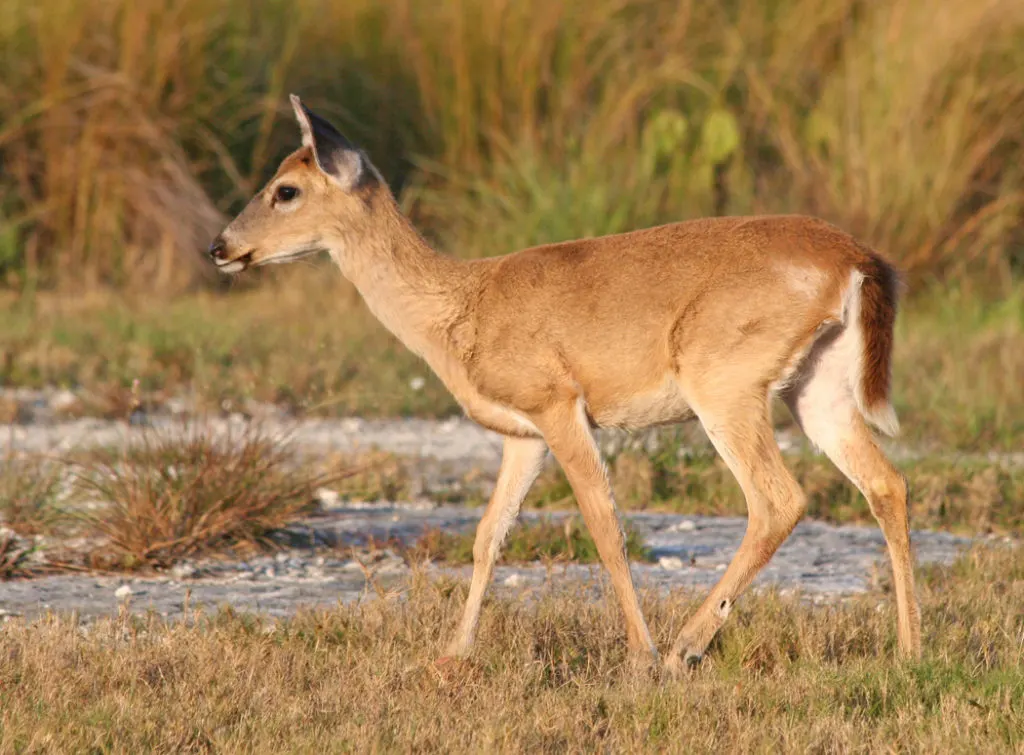
Image credit – wikipedia
Florida Black Bear (Ursus americanus floridanus)
While these bears may seem cute and cuddly from afar, I vote strongly against trying to pet them!
Florida black bears typically aren’t aggressive towards humans, but they are large powerhouses, and they’ve been known to react strongly when provoked. If you encounter one in the wild, make sure to give it some space!
The majority of black bears in Florida live on or near nature preserves such as Ocala National Forest, Osceola National Forest, Big Cypress National Preserve, and Apalachicola National Forest, to name a few.
These large mammals are omnivores, meaning they eat both plants and animals. However, plants, grasses, and leaves usually make up at least 80% of their diet.
Fun Facts!
- Black bears are the only species of bears native to Florida.
- The largest black bear to ever be recorded in Florida weighed about 760 pounds!
- Even though black bears are known for being slow-moving, they can move very quickly when necessary! When chasing prey or avoiding threats, they can move up to 30 miles per hour, though only for short distances.
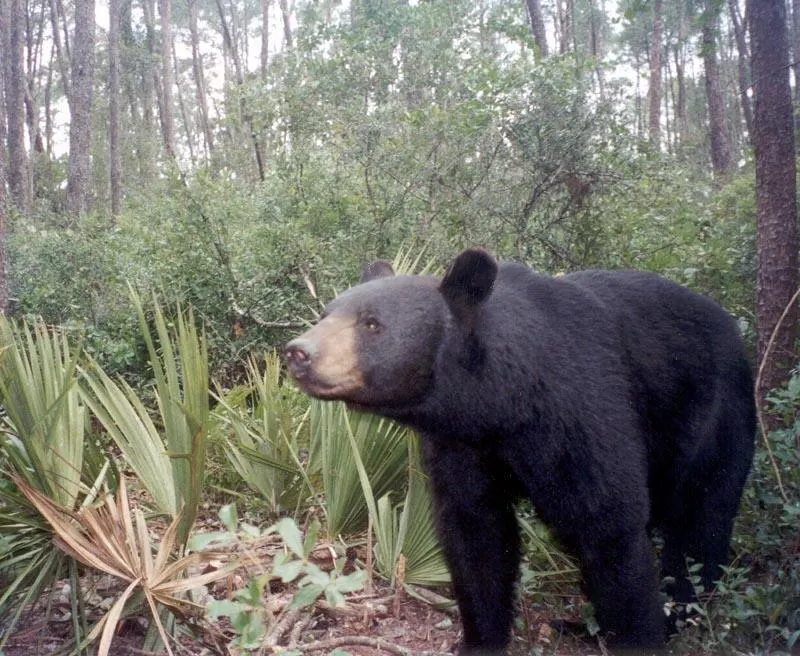
Image credit – wikipedia
American Crocodile (Crocodylus acutus)
It can be difficult to differentiate American crocodiles from Native American alligators. However, the biggest difference is in coloring and snout shape. Another key difference is habitat preference.
As we discussed earlier in the article, alligators prefer freshwater habitats over saltwater ones, however, crocodiles prefer the opposite. Most commonly, they make their homes in brackish water areas such as mangrove swamps in South Florida. If you’re looking to spot some crocodiles, I highly recommend checking out Everglades National Park, Biscayne National Park, and Ding Darling National Wildlife Refuge!
Like every other crocodile species in the world, American crocodiles will eat almost anything it encounters, making it a type of scavenger. Much like the alligator, what the crocodile eats depends on its size. They are also known to scavenge dead animal carcasses when they can find them.
Fun Facts!
- Crocodiles spend a big portion of their days laying in the sun, often with their mouths held open. This is known as “gaping,” which helps them to regulate their body temperature.
- In the 1970s, there were only a few hundred crocodiles living in the swamps of South Florida. Today, there are approximately 3000!
- American crocodiles are one of the largest crocodile species worldwide. They can grow up to 15 feet in length and weigh up to 900 pounds!
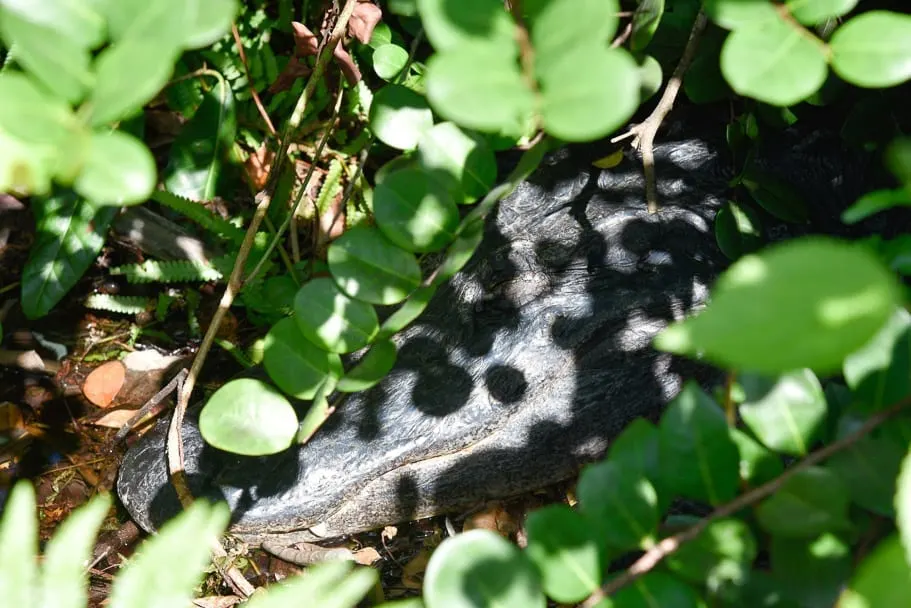
Moon Jellyfish (Aurelia aurita)
While these graceful swimmers may look lovely, I strongly advise against getting too close!
Moon jellyfish are most commonly seen in the waters surrounding the Florida Keys. They populate temperate, coastal waters all over the world. Their predators include sea turtles, sunfish, and sometimes even other jellyfish!
It’s not super uncommon to get stung by a Moon jellyfish while swimming in Florida, and while their stings can be very uncomfortable, it’s usually not a medical emergency. It can be difficult to see this particular species of jellyfish in the water, as they are nearly transparent! You can usually spot large amounts of Moon jellyfish in the waterways around Cape Canaveral’s Jetty Park, or at Santa Rosa beach, depending on the time of year. During the late spring and summer months, you’ll see much larger groups!
Moon jellyfish are carnivores, with a diet that primarily includes larval organisms and zooplankton.
Fun Facts!
- The “body” of a Moon jellyfish is actually 95% water, with no circulatory, excretory, or respiratory systems.
- Moon jellyfish can shrink down to one-tenth of their full size when there isn’t enough food around. This adaptation helps them save energy until they reach an area that has a larger food source.
- Jellyfish are one of the strongest bioindicators concerning the health of our oceans. Because of their ability to adapt quickly and survive in low-oxygen environments, researchers are able to determine the survivability of our local waters by monitoring jellyfish.
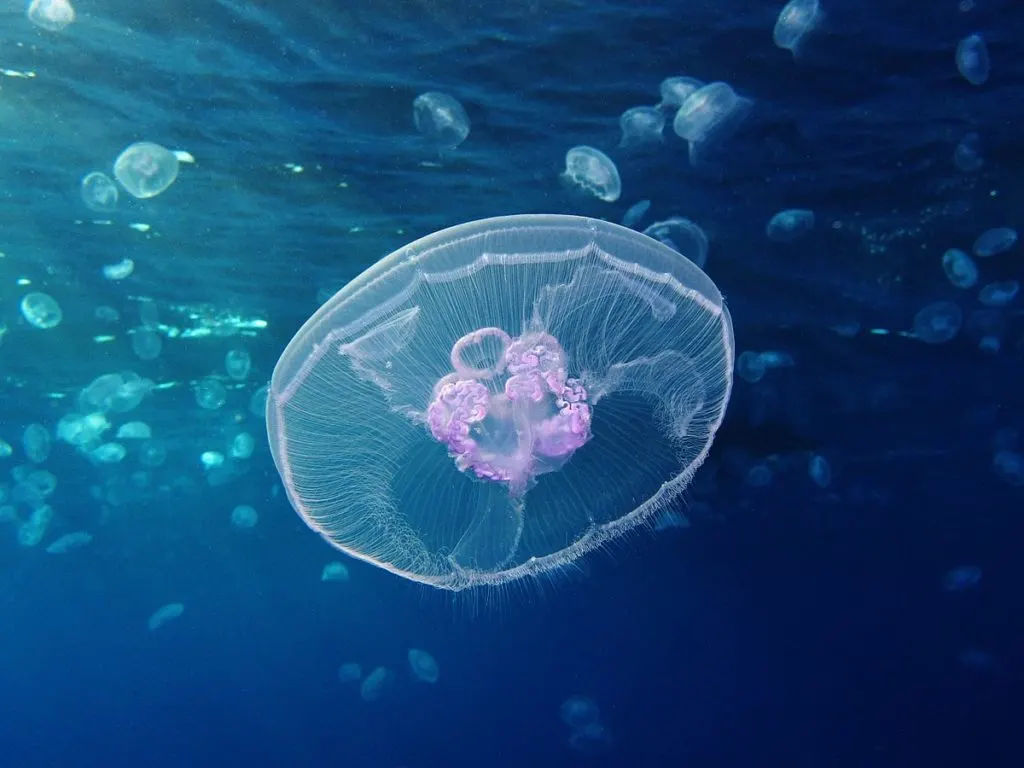
Image credit – wikipedia
River Otter (Lontra canadensis)
Moving onto animal number 8 in our list, the river otter! River otters are social creatures, but they can be protective and sometimes aggressive towards humans who get too close. They typically move in groups consisting of a mother and her pups. River otters love spending time in freshwater, and can be found all throughout the state of Florida, except for the Florida Keys. Try searching for them in Ichetucknee Springs State Park or Torry Island, located along Lake Okeechobee!
River otters primarily feed on fish and crayfish, but they aren’t very picky. In some cases, otters will even attack and feed on alligators! Talk about small but mighty!
Before we move on, here are some fun facts you “otter” know…like what I did there?
- River otters will sometimes take over and “remodel” a beaver’s burrow and make their own home in it.
- The coloring of an otters fur can range from a light shade of brown to a very dark, rich shade.
- While swimming underwater, these otters can hold their breath for up to 8 minutes, and are able to dive to depths of 60 feet!
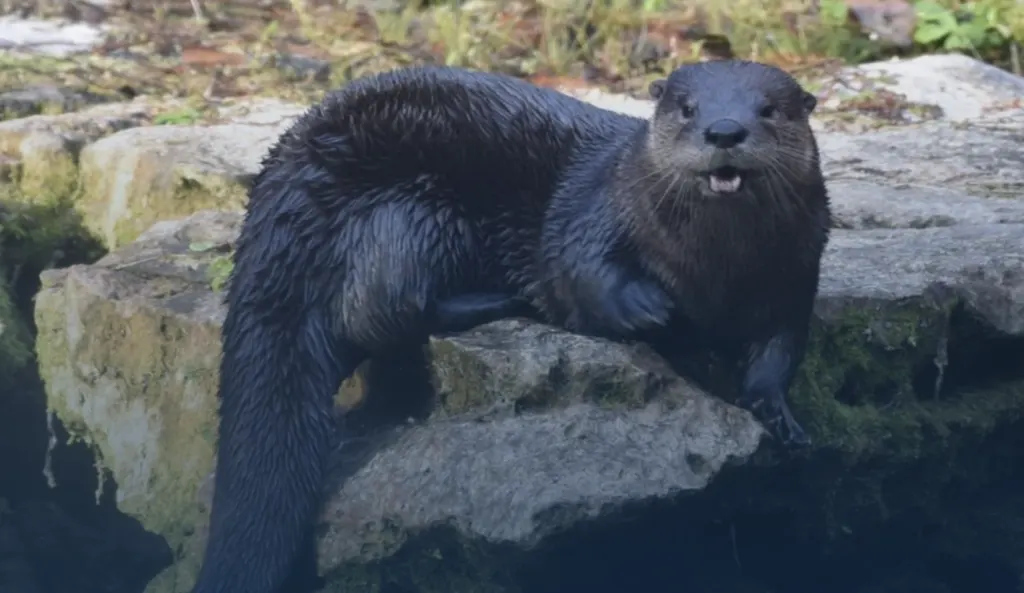
Image credit: Florida State Parks
Southern Cricket Frog (Acris gryllus)
While these rough tree frogs can be many different colors, they all have a bright stripe running up its back, which ends in a unique, triangle pattern between its eyes. They can be spotted all throughout Florida, with the exception of the Florida Keys, much like the River otter.
Southern Cricket Frogs create their breeding sites in most freshwater areas in the state. While this breed is technically a tree frog, they live on the ground in locations around small, shallow bodies of water such as creeks or even roadside ditches.
Southern Cricket frogs feed on grasshoppers, ants, spiders, flies, and many other small invertebrates. I recommend searching for them near creeks and South Florida swamps!
Fun Facts!
- While in the tadpole stage, Southern Cricket frogs only feed on plants.
- These frogs get their name from their mating call, which sounds like a clicking or sharp tapping. This call is often mistaken for the sound a cricket makes!
- Southern Cricket frogs are some of the best jumpers in the amphibian world, with a maximum jump height of nearly 8 feet!
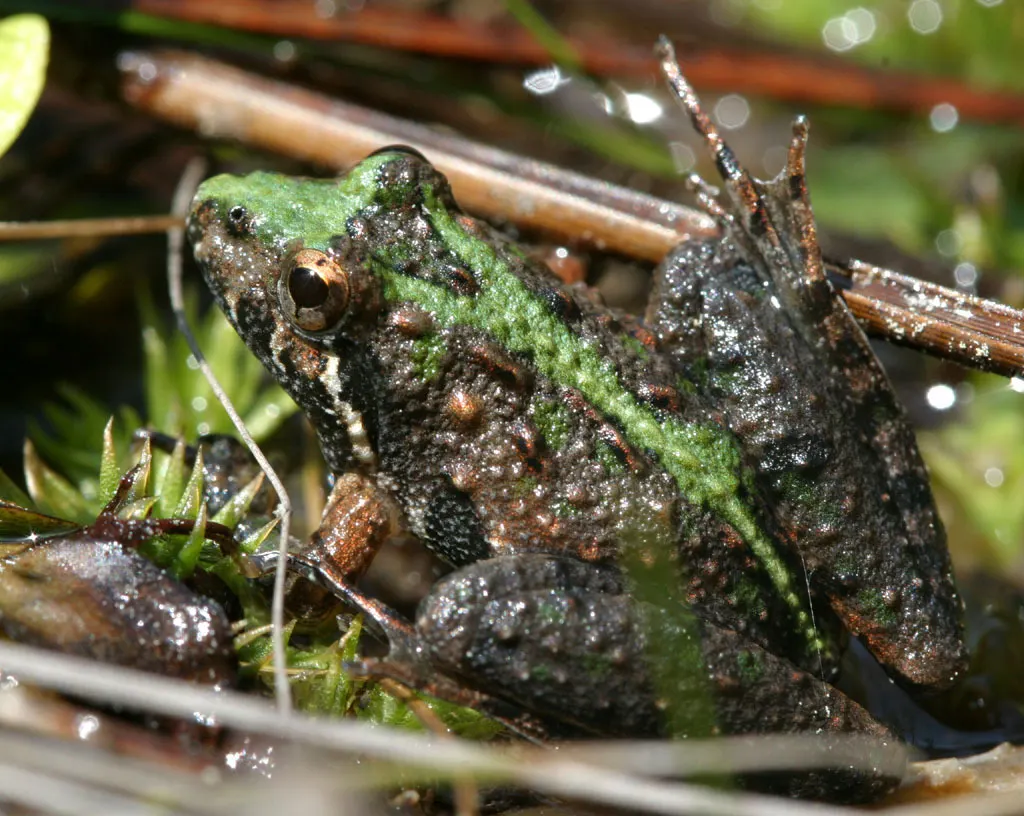
Image credit: Inaturalist
Florida Gar (Lepisosteus platyrhincus)
These native fish are very common throughout the streams and lakes of Florida and Southern Georgia. They are characterized with irregular black spots all over their olive-brown body. Florida Gar can survive even in stagnant, hot waters that are unlivable for most other species of fish. This is due to a highly-vascularized air bladder that is connected to its throat.
Florida gar prefer to make their home in the muddy vegetation at the bottom of rivers. This contrasts the behaviors of their close relative, the Long-nose gar, as they prefer to live in populated, open water. If you’re an angler hoping to catch some Florida gar, it’s very likely that you’ll find an abundance of them in most canals. Their diets usually include small fish, zooplankton, crustaceans, and various insects.
Fun Facts!
- Their body is covered with very tough, diamond-shaped scales. These are called “ganoid scales”.
- A Florida gar’s roe is toxic to humans.
- While they are commonly found in rivers all over the state, they aren’t particularly valuable fish for recreational fishing.
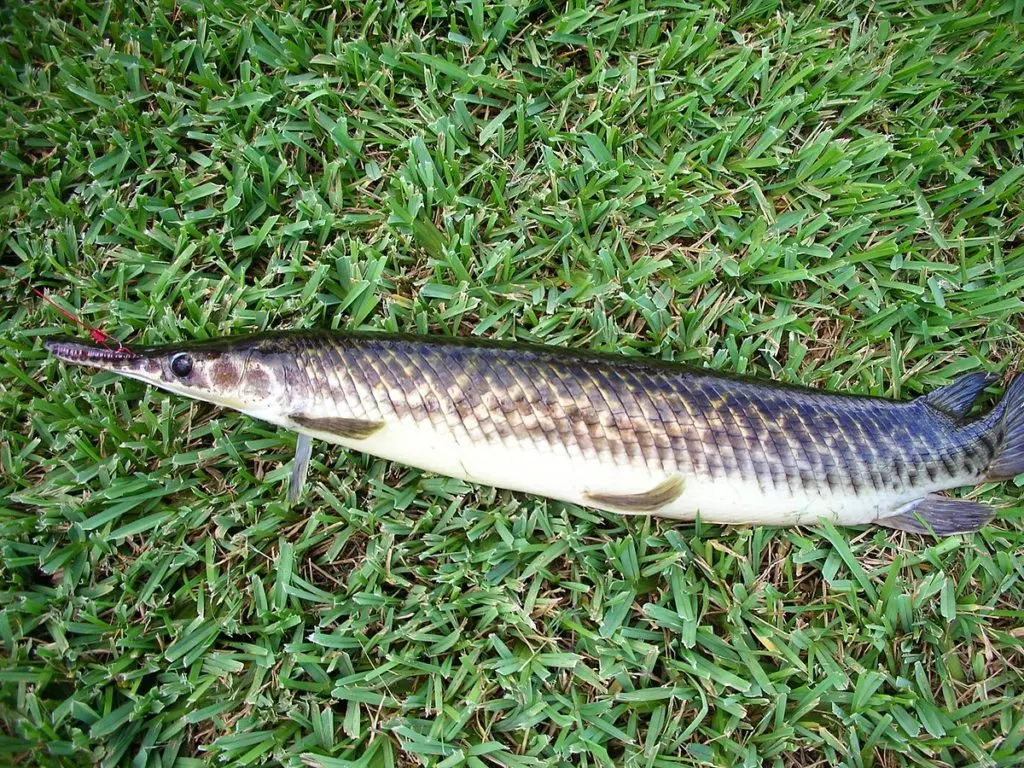
Image credit: Wikipedia
Gopher Tortoise (Gopherus polyphemus)
These long-lived reptiles build their burrows throughout all 67 counties of Florida in forests, nature preserves, yards, and pastures. They can live up to 60 years old in the wild, while captive tortoises may live over 90 years!
Gopher tortoises are herbivores, and their diets consist of low-growing plants like grasses and bean plants. While all Gopher tortoises typically have the same diet, they will eat whatever plants are most dominant in their given location. I recommend exploring Seabranch Preserve State Park, either by bicycle or on foot, if you’re hoping to have an encounter with a Gopher tortoise!
I’ve had the pleasure of observing several Gopher tortoises myself, and they are truly amazing creatures. If you do see one in the wild, take care in keeping your distance, as these reptiles are protected under state law.
Fun Facts!
- The Gopher tortoise is the only kind of tortoise that is naturally found anywhere east of the Mississippi River.
- You can tell males apart from females of the species based on the absence or presence of a concavity on the lowest part of their shell! Adult male tortoises will have this concavity, while adult females will have a flat lower shell.
- These tortoises are named after their ability to dig huge, deep burrows like gophers do. They are true ecosystem engineers!
Tip: You can often see gopher tortoises in Marco Island and the beaches nearby.
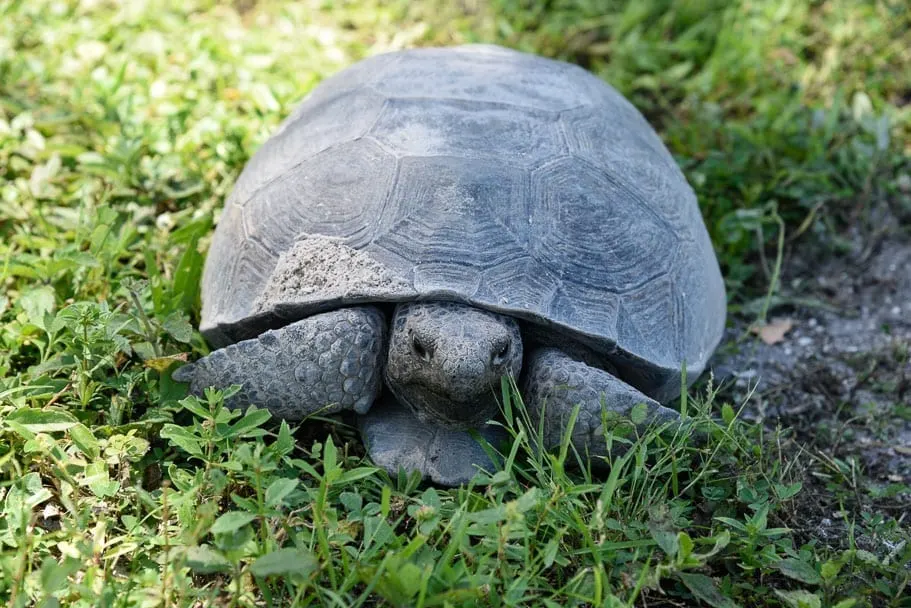
Marsh Rabbit (Sylvilagus palustris)
These adorable little rabbits are the slightly smaller relative of the commonly known cottontail rabbit. The biggest difference between the two is the look of their tails. While the Eastern cottontail rabbit has a “cotton puff” tail, the marsh rabbit has a small brown-gray tail.
The biggest threat to the Marsh rabbit population in Florida are hurricanes and coastal flooding that takes place almost annually during hurricane season each year. These storms can take a large toll on the species, especially nestlings and younger rabbits.
Marsh rabbits build their homes pretty much everywhere in Florida, from marshes to agricultural fields. They are herbivores, so they feed on a wide variety of plants in and around wetlands.
Fun Facts!
- Marsh rabbits only live in habitats that have ready access to water, unlike most other rabbits.
- These rabbits are excellent swimmers! In fact, they will often dive underwater while evading predators.
- They are nocturnal creatures, meaning they are most active at night.
Black-bellied whistling duck (Dendrocygna autumnalis)
This unique breed of duck has grown in population exponentially over the past few decades. This is because the Black-bellied whistling duck is able to adapt to almost any habitat. If you’re looking to spot one, make sure to visit the Corkscrew Swamp Sanctuary in Naples, Florida! It’s likely that you may also come across them in many urban or rural areas all throughout the state.
Black-bellied whistling ducks are omnivores, meaning they have a combination diet of both plants and meat. For the most part, they will feed under the cover of night on corn, seed, rice, spiders, snails, and other insects.
Fun Facts!
- They typically build their nests on the ground, or in nest boxes.
- They live together in flocks of roughly 1000 birds. Quite a family reunion!
- They get their name from the whistle-like calls they make.
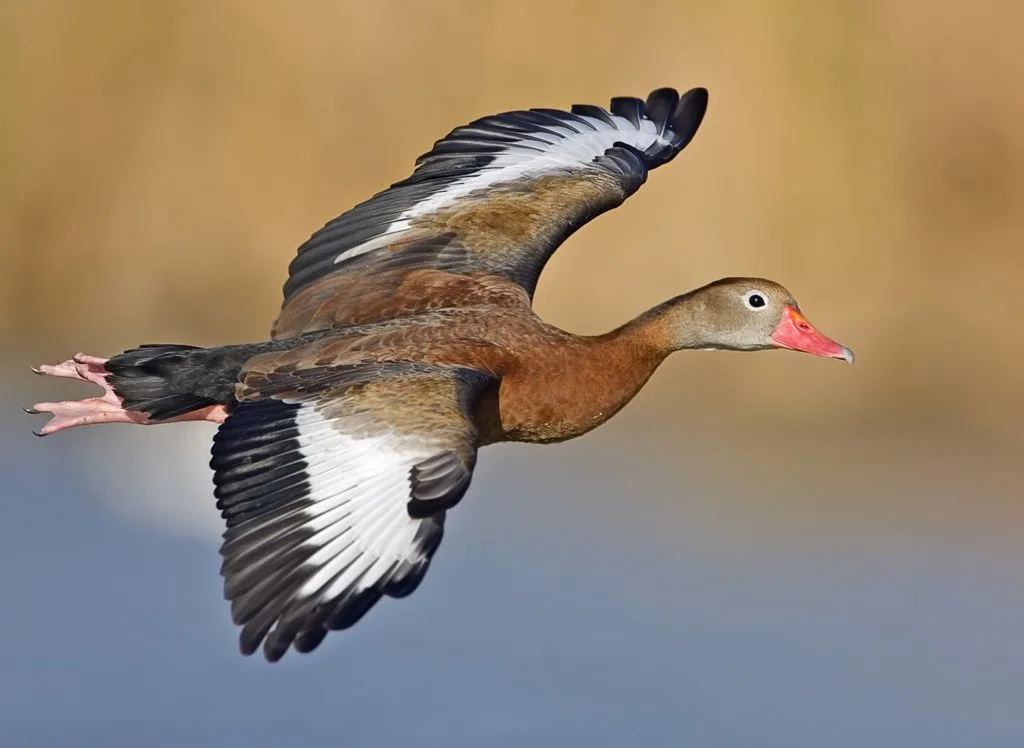
Bobcat (Lynx rufus)
While they are extremely cute, these tough kitties are much different from your everyday house cat. In fact, most bobcats are about twice the size of your average domestic cat! Bobcats are found in many locations all over the state of Florida in deep forests, hammock land, and swamps.
They will seek out areas with thick patches of saw palmetto and dense shrubs, as those types of plants are very important for building dens and places to rest. Additionally, these wildcats are very territorial. In rural areas, bobcats will “claim” around 5 to 6 miles as their home and patrol it carefully for threats or prey.
In heavily populated or suburban areas, that range of territory is about 1 to 2 miles. A great place to spot bobcats out in the wild is Merritt Island National Wildlife Refuge, located near Cape Canaveral!
Floridian bobcats tend to hunt rabbits, squirrels, and rats, though sometimes they’ll even prey on domestic chickens or other ground-dwelling birds.
Fun Facts!
- The bobcat is the most common wildcat in North America!
- While bobcats have the ability to hunt large prey such as deer, they more commonly will prey on rodents and rabbits.
- Female bobcats teach their young how to hunt and live independently before they’re 1 year old. Talk about an advanced education!
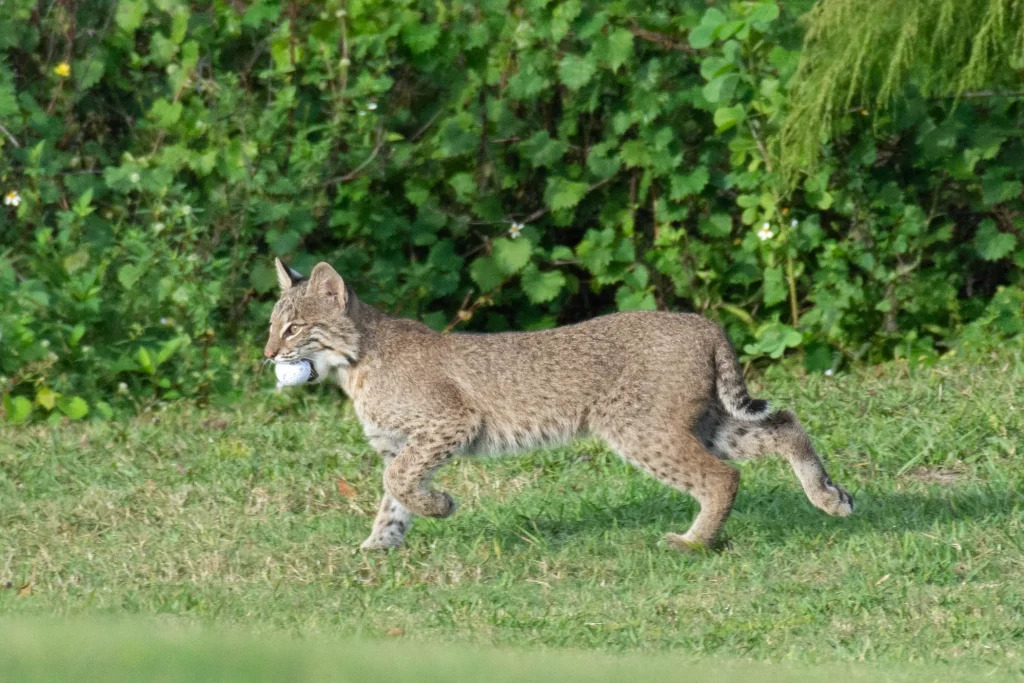
Image credit: Naples Daily News
****
See more:

